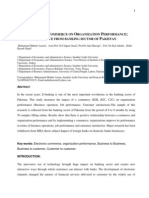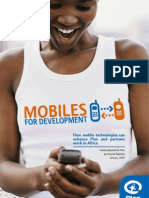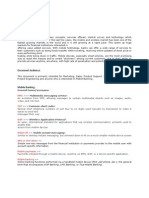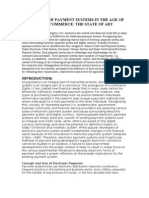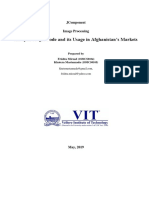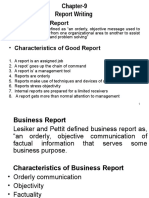E-Wallet System For Bangladesh An Electronic Payment
E-Wallet System For Bangladesh An Electronic Payment
Uploaded by
shaane16649Copyright:
Available Formats
E-Wallet System For Bangladesh An Electronic Payment
E-Wallet System For Bangladesh An Electronic Payment
Uploaded by
shaane16649Original Title
Copyright
Available Formats
Share this document
Did you find this document useful?
Is this content inappropriate?
Copyright:
Available Formats
E-Wallet System For Bangladesh An Electronic Payment
E-Wallet System For Bangladesh An Electronic Payment
Uploaded by
shaane16649Copyright:
Available Formats
International Journal of Modeling and Optimization, Vol. 4, No.
3, June 2014
E-Wallet System for Bangladesh an Electronic Payment
System
Mohammad Salah Uddin, Member, IACSIT, and Afroza Yesmin Akhi
store money; a safe, easy way to make payments and money
transfers. Fig. 1 shows the architecture of bkash.
The bKash mobile wallet is a VISA technology platform
which is fully encrypted to ensure most secure transactions,
will be the customer account into which money can be
deposited and out of which money can be withdrawn or used
for various services. Customers will be able to receive
electronic money into their bKash accounts through salary,
loan, domestic remittance, and other disbursements and
eventually will cash out the electronic money from bkash
authorized agents/ATM [2]. There are several cons of bkash,
the service is not available everywhere in Bangladesh. There
are four mobile operator in Bangladesh but till now all the
mobile operators are not covered by bkash. The existence of
bank account is totally forbidden in bkash system.
AbstractThe purpose of this paper is to contribute to the
design of e-wallets for Bangladesh, an Electronic Payment
System (ETS). E-wallets are intended to replace the existing
physical wallet, with its notes, coins, plastic cards, ATM cards
and loyalty cards etc.
Now a day, the challenges of payment transactions were
initially underestimated. Business via the internet and mobile
telephony has so far been dominated by the methods of payment
systems in traditional business. However, in light of advances in
technology, traditional business models are increasingly coming
up against their limits. e-wallet is a convenient, easy-to-use,
secure payment system. It is flexible Electronic payment
system with a number of payout and pay-in options via bank
account and Credit/Debit cards.
Index TermsE-Wallet, electronic payment
microsoft wallet, bkash, NPS, POS, e-commerce.
system,
B. National Payment Switch
Bangladesh bank launched National Payment Switch
(shows in Fig. 2) in 2012, a common platform for the
country's commercial banks for electronic payments, which
is going to revolutionize E-commerce in Bangladesh. Once
all banks in Bangladesh join the NPS (National Payment
Service), a customer using a credit or debit card of any bank
will be able to draw cash from any ATM and POS (point of
sales) in the country, and transaction costs will significantly
go down as the transactions will be routed through the NPS
instead of Visa, Master or Amex card networks abroad.
Moreover, purchase and sale can be done with cards through
the internet and web portals within the country [3]. NPS will
facilitate easy access to funds, an increase in tax revenue,
more flow of money in the economy, and financial inclusion.
NPS is a common electronic payment platform to help banks
and their clients make transactions in an easy and cost
effective way. Individual payment platforms introduced by
different banks will be abolished once all banks join the
common platform.
I. INTRODUCTION
The digital revolution continues to transform most aspects
of our daily life. In particular, the digital revolution has
resulted in the vertical convergence of business channel
capacities [1]. The digital revolution also continues to
transform the public sector organizations and services. For
instance, the DMP (Dhaka Metropolitan Police) receive GD
(General Diary) application via online, Passport application,
TIN (Tax Identification Number) registration, University
admission etc. are also submitted through online. Other
examples are Train tickets bought via mobile phones, online
purchases, and social interactions made via SMS, emails and
social networks. A next step in the digital revolution is the
transformation of the time honored traditional physical wallet
into the e-wallet.
II. RELATED TECHNOLOGY IN BANGLADESH
C. Internet Banking or Online Banking
Online banking (or Internet banking or E-banking) allows
customers of a financial institution to conduct financial
transactions on a secured website operated by the institution,
which can be a retail bank, virtual bank, credit union or
building society.
To access a financial institution's online banking facility, a
customer having personal Internet access must register with
the institution for the service, and set up some password
(under various names) for customer verification. The
password for online banking is normally not the same as for
[telephone banking]. Financial institutions now routinely
allocate customers numbers (also under various names),
whether or not customers intend to access their online
A. Bkash
Bangladeshs first complete mobile financial service
provider, bKash Limited, a BRAC Bank subsidiary, launched
its mobile banking operation in July 2011. bKash is designed
to provide financial services via mobile phones to both the
unbanked and the banked people of Bangladesh. The overall
bKash value proposition is simple: a safe, convenient place to
Manuscript received January 24, 2014; revised May14, 2014.
Mohammad Salah Uddin is with Dipartimento di Informatica e
Sistemistica Sapienza Universit`a di Roma, Rome, Italy (e-mail:
akash.bangla@gmail.com).
Afroza Yesmin Akhi is with the Department of Computer Science and
Engineering, East West University, Dhaka, Bangladesh (e-mail:
ankhi.ayaz@yahoo.com).
DOI: 10.7763/IJMO.2014.V4.376
216
International Journal of Modeling and Optimization, Vol. 4, No. 3, June 2014
to another user is not possible. Some banks provide mobile
recharge and WI-max recharge facilities.
banking facility. Customers numbers are normally not the
same as account numbers, because number of accounts can
be linked to the one customer number. The customer will link
to the customer number any of those accounts which the
customer controls, which may be cheque, savings, loan,
credit card and other accounts. Customer numbers will also
not be the same as any debit or credit card issued by the
financial institution to the customer.
To access online banking, the customer would go to the
financial institution's website, and enter the online banking
facility using the customer number and password. Some
financial institutions have set up additional security steps for
access, but there is no consistency to the approach adopted.
Online banking facilities offered by various financial
institutions have many features and capabilities in common,
but also have some that are application specific. The common
features fall broadly into several categories
D. SMS Banking
SMS banking is a type of mobile banking, a
technology-enabled service offering from banks to its
customers, permitting them to operate selected banking
services over their mobile phones using SMS messaging.
SMS banking services are operated using both push and
pull messages. Push messages are those that the bank chooses
to send out to a customer's mobile phone, without the
customer initiating a request for the information. Typically
push messages could be either Mobile marketing messages or
messages alerting an event which happens in the customer's
bank account, such as a large withdrawal of funds from the
ATM or a large payment using the customer's credit card, etc.
Pull messages are those that are initiated by the customer,
using a mobile phone, for obtaining information or
performing a transaction in the bank account. Examples of
pull messages for information include an account balance
enquiry, or requests for current information like currency
exchange rates and deposit interest rates, as published and
updated by the bank.
Typical push and pull services offered under SMS
banking:
1) A bank customer can perform non-transactional tasks
through online banking, including
a) viewing account balances
b) viewing recent transactions
c) downloading bank statements, for example in PDF
format
d) viewing images of paid cheques
e) ordering cheque books
f) download periodic account statements
g) Downloading applications for M-banking, E-banking
etc.
1) Typical push services would include:
a) Periodic account balance reporting (say at the end of
month)
b) Reporting of salary and other credits to the bank
account
c) Successful or un-successful execution of a standing
order
d) Successful payment of a cheque issued on the account
e) Insufficient funds
f) Large value withdrawals on an account
g) Large value withdrawals on the ATM or EFTPOS on
a debit card
h) Large value payment on a credit card or out of
country activity on a credit card.
2) Bank customers can transact banking tasks through
online banking, including
a) Funds transfers between the customer's linked
accounts
b) Paying third parties, including bill payments (see, e.g.,
BPAY) and telegraphic/wire transfers
c) Investment purchase or sale
d) Loan applications and transactions, such as
repayments of enrollments
e) Register utility billers and make bill payments
3) Financial institution administration
a) Management of multiple users having varying levels
of authority
b) Transaction approval process the process of banking
has become much faster
2) Typical pull services would include:
a) Account balance enquiry
b) Mini statement request
c) Electronic bill payment
d) Transfers between customer's own accounts, like
moving money from a savings account to a current
account to fund a cheque
e) Stop payment instruction on a cheque
f) Requesting for an ATM card or credit card to be
suspended
g) De-activating a credit or debit card when it is lost or
the PIN is known to be compromised
h) Foreign currency exchange rates enquiry
i) Fixed deposit interest rates enquiry
4) Some financial institutions offer unique Internet banking
services, for example
a) Personal financial management support, such as
importing data into personal accounting software.
Some online banking platforms support account
aggregation to allow the customers to monitor all of
their accounts in one place whether they are with their
main bank or with other institutions.
The feature of Internet banking in Bangladesh is totally
different. Most of the private bank provides internet banking
service for customers. This is not pure internet banking, its a
demonstration only. Users/ customers just check their
balance, show their account statement, money transfer is
possible (within own account). Money transfer from one user
III. E-WALLET
An electronic wallet is a program or web service that
allows users to store and control their online shopping
information, like logins, passwords, and shipping address
217
International Journal of Modeling and Optimization, Vol. 4, No. 3, June 2014
service directly from our bank account, transfer money to
others (e-wallet users), issuing e-checks, e-cash, e-pay-order
etc. In other word, the whole banking services should be done
by e-wallet. We linked our several bank accounts to e-wallet.
We also link our credit/debit card; use them through e-wallet.
e-wallet must be connected to National payment switch for
getting more benefits. Fig. 3 shows the architecture of
e-wallet.
e-wallets allow us to keep track of our billing and shipping
information so that it can be entered with one click at
participating merchants' sites.
The most common example of e-wallet system is Paypal. It
is a fast way to pay and get paid online. Paypal allows people
to send money without sharing financial information. People
also have the flexibility to pay using their account balances,
bank accounts, and credit cards. As of 2014, there are over
143 million active Paypal accounts, in 193 markets, and 26
currencies worldwide. PayPal allows for global commerce,
through which it processes over 9 million payments each day.
PayPal, which was bought by eBay for $1.3 billion in late
2002, had contributed to 41 percent of eBay's revenues in
2013. It is nationally headquartered in San Jose, California,
and internationally headquartered in Singapore. [6]
Another popular example of an e-wallet on the market is
Microsoft Wallet. To obtain Microsoft Wallet, one needs to
set up a Microsoft Passport. After establishing a Passport, a
Microsoft e-wallet can be established. Then, e-wallets can be
used for micro-payments. They also eliminate reentering
personal information on the forms, resulting in higher speed
and efficiency for online shoppers. Microsoft Passport
consists of several services including, a single sign-in, wallet
and kids passport services. A single sign-in service allows the
customer to use a single name and password at a growing
number of participating e-commerce sites. The shopper can
use to make fast online purchases with a wallet service [7].
Kids passport service helps to protect and control children's
online privacy.
We should protect our wallet file with a password. With a
password protected wallet we must enter the wallets
password before we can see the information on any of the
cards/accounts in that wallet.
and credit card details, in one central place. It also provides a
convenient and technologically quick method for consumers
to purchase products from any person or store across the
globe. [4] Generally, the payment process is (before that a
user must done their registration and collect their PIN):
Fig. 1. The architecture of bkash.
Fig. 2. National payment switch.
A. Starting with e-Wallet
When we start e-wallet for the first time, we are prompted
to create a new wallet file to store our information in. When
were ready to add our own information, we can add new
categories and cards to wallet and organize the information in
a way that fits our needs.
e-wallet protects our wallet information in two ways:
Fig. 3. Architecture of e-wallet.
1) User login their account using their ID and PIN
2) Choose their suitable payment method and perform the
operation
1) By requiring a password before displaying any cards/
accounts in a password protected wallet.
2) By encrypting (making unintelligible) the information in
cards/accounts in password protected wallets in our
wallet file. This means that the information in the file is
translated into a secret code so that it cant be read by any
other program.
The electronic wallet (e-wallet) provides all of the
functions of todays wallet on one convenient smart card
eliminating the need for several cads. The e-Wallet will also
provide numerous security features not available to regular
wallet carriers. e-wallet is a digital wallet which allows users
to make electronic transactions quickly and securely [5].
In our proposed e-wallet, we directly linked our bank
account to it. We assume that, its a one kind of internet
banking with more features such as purchase goods and
B. Backup
For extra safety, we encourage to take backups of our
e-wallet files (as well as all of our important information).
218
International Journal of Modeling and Optimization, Vol. 4, No. 3, June 2014
e-wallet will automatically make a backup of our wallet file
each time we close e-wallet.
important measure to establish trust between online seller and
buyer [8]. Encryption and decryption allow secure transfer of
information between an Internet browser and server. Data
cannot be intercepted or changed during transmission. SSL
also permits merchant identification through SSL server
certificates. The SSL standard has been widely adopted
because it is relatively simple and easy to use and does not
place excessive demands on the average consumers home
PC. SSL has an over 90% share of security measures, about
the same as credit cards among online payment systems.
Until recently, SSL provided services exclusively for fixed
networks. But as mobile networks are increasingly important
e-commerce markets, SSL services for wireless devices have
been developed.
C. Technology in e-Wallet
A digital wallet has both a software and information
component. The software provides security and encryption
for the personal information and for the actual transaction.
Typically, digital wallets are stored on the client side and are
easily self-maintained and fully compatible with most
e-commerce web sites. A server-side digital wallet, also
known as a thin wallet, is one that an organization creates for
and maintains on its servers. Server-side digital wallets are
gaining popularity among major retailers due to the security,
efficiency, and added utility it provides to the end-user,
which increases their enjoyment of their overall purchase.
The information component is basically a database of
user-inputted information. This information consists of
shipping address, billing address, payment methods
(including credit card numbers, expiry dates, and security
numbers), and other information.
D.
1)
2)
3)
4)
5)
6)
7)
8)
9)
10)
11)
12)
C. Secure Electronic Transaction (SET)
SET is an alternative, more complex security system based
on digital certificates and signatures [9]. SET needs specific
software and is more difficult for cardholders to obtain and
use, and despite the high level of security offered it has not
gained widespread use.
Benefits of e-Wallet
Send and receive payments within Bangladesh.
Unlimited transfers.
Easy recurring payments and transfer.
Online and offline Shopping
Manage our account from our mobile phone.
Security for our bank account and credit card numbers.
Email or SMS notifications after transactions
We are in complete control.
Pull money into our e-wallet from any bank account.
Receive wired funds/transfers directly into our e-wallet.
Link any bank account within Bangladesh.
Transfer money from e-wallet to e-wallet without
sharing personal account numbers.
V. CONCLUSION
The main discussion of the paper is e-wallet an
Electronic payment System for Bangladesh, which replaced
the traditional wallet that contains notes, coins, checks and
Credit/Debit/ATM cards. The system will be developed if the
Government of Bangladesh provides necessary support.
Since its a web-based system, any device can access the
system via internet.
REFERENCES
[1]
[2]
[3]
IV. ISSUES FOR E-WALLET
Main issue that should be taken care of for electronic
payments system is Authentication which identifies buyer
and also makes sure that person is who he/she claims to be.
Used methods are i.e. digital signature, finger prints, two
steps verification (like Gmail), password or smartcards etc.
Data integrity which means, that there must be a way to
verify that data is not changed during the transactions.
Confidentially must also be preserved.
A. Security for Online Systems
Security of a customer's financial information is very
important, without which online system could not operate.
There are set up various security processes to reduce the risk
of unauthorized online access to a customer's records, but
there is no consistency to the various approaches adopted.
The use of a secure website has become almost universally
adopted.
Though single password authentication is still in use, it by
itself is not considered secure enough for online system in
some countries. Basically there are two main systems for
transaction security, secure socket layer and secure electronic
Transaction.
[4]
[5]
[6]
[7]
[8]
[9]
H. Li and J. D. Leckenby, Examining the effectiveness of internet
advertising formats, Internet Advertising: Theory and Research, p.
528, 2007.
BRAC Bank's bKash, PRWEB July 22, 2011.
Bangladesh Bank opens gateway to e-commerce, The Daily Star,
December 28, 2012.
Safe Internet Banking. [Online]. Available: www.fdic.gov
Digital wallet. [Online]. Available: http://www. en.wikipedia.org.
Paypal. [Online]. Available: http:// www.paypal-media.com.
D. Kosivr, Understanding Electronic Commerce: How Online
Transactions Can Grow your Business, Microsoft Press, 1997.
W. Xu, E-commerce online payment security issues, Joint Hefei
University Journal, 2000, vol. 3, pp. 23-25.
J. Zhang, Analyzes based on the SET agreement electronic commerce
safety mechanism, Netinfo Security, 2006, vol. 10, pp. 9-11.
Mohammad Salah Uddin was a PhD student in
Dipartimento di Informatica e Sistemistica Sapienza
Universit`a di Roma, Rome, Italy. He previously works
as a lecturer in the Department of Computer science and
Engineering, Central Womens University, Dhaka,
Bangladesh. He has been published several journal and
international conference paper from his research work.
He is a member of IACSIT and Software Engineering and
Formal Method Research Group of East West University. He received his
B.Sc in computer science and engineering from East West University, Dhaka,
Bangladesh in 2012. He is interested in:- web service composition, semantic
web service, knowledge representation, mobile apps, software engineering,
software product line, modeling and verification.
Afroza Yesmin Akhi was a B.Sc student in the
Department of Computer Science and Engineering, East
West University, Dhaka, Bangladesh. She is a member of
Web Engineering Research Group, East West University.
She is currently working towards web application
development. She is also interested in Mobile apps.
B. Secure Socket Layer (SSL)
SSL is the widely used secure service system and is an
219
You might also like
- Symap A2 Eventbuilder EDocument54 pagesSymap A2 Eventbuilder EAlfredo Jiménez100% (3)
- Final New ProjectDocument85 pagesFinal New ProjectAnkit0% (1)
- Mobile BankingDocument10 pagesMobile BankingProfessor Sameer Kulkarni100% (5)
- InLine PoM Edition GruebelDocument28 pagesInLine PoM Edition GruebelFabio WenoNo ratings yet
- B. F. Skinner - Upon Further Reflection - (1987)Document212 pagesB. F. Skinner - Upon Further Reflection - (1987)NB100% (11)
- Review of Some Online Banks and Visa/Master Cards IssuersFrom EverandReview of Some Online Banks and Visa/Master Cards IssuersNo ratings yet
- TRUSTING MOBILE PAYMENT: HOW THE TRUST-FACTOR FORMS THE MOBILE PAYMENT PROCESSFrom EverandTRUSTING MOBILE PAYMENT: HOW THE TRUST-FACTOR FORMS THE MOBILE PAYMENT PROCESSNo ratings yet
- Mobile Payment L Six IssuesDocument17 pagesMobile Payment L Six IssuesiAditya100% (4)
- E WalletDocument15 pagesE WalletManoj Kumar Paras100% (1)
- Internet Banking PDFDocument19 pagesInternet Banking PDFJadhav NikitaNo ratings yet
- A Study On Consumer Preference Towards eDocument5 pagesA Study On Consumer Preference Towards eVu Van DiepNo ratings yet
- Biometric Payment TechnologiesDocument3 pagesBiometric Payment TechnologiesInternational Journal of Innovative Science and Research TechnologyNo ratings yet
- Security of Mobile BankingDocument13 pagesSecurity of Mobile BankingJehanzeb RaufNo ratings yet
- Internet Banking Report - FinalDocument9 pagesInternet Banking Report - FinalImaad Ali Khan100% (2)
- E-Payment in India PDFDocument6 pagesE-Payment in India PDFM Goutham100% (1)
- Bachan Das - Banking Final ProjectDocument27 pagesBachan Das - Banking Final ProjectbachandasNo ratings yet
- Transformation of E-Payment & It's Impact On BanksDocument36 pagesTransformation of E-Payment & It's Impact On BanksPinky Gupta100% (3)
- Impact of Technology in Banking Industry FINAL PAPERDocument8 pagesImpact of Technology in Banking Industry FINAL PAPERSam MumoNo ratings yet
- Impact of E-Commerce On Organization Performance Evidence From Banking Sector of PakistanDocument18 pagesImpact of E-Commerce On Organization Performance Evidence From Banking Sector of PakistanMEHTABAZEEMNo ratings yet
- A Comprehensive Cyber Security Framework For Mobile Financial ServicesDocument14 pagesA Comprehensive Cyber Security Framework For Mobile Financial Servicessaleem razaNo ratings yet
- Effect of Mobile Banking On Financial Performance-921Document10 pagesEffect of Mobile Banking On Financial Performance-921Rossya FinaNo ratings yet
- Mobile Banking Conceptual ModelDocument21 pagesMobile Banking Conceptual ModelGill Varinder SinghNo ratings yet
- Mobiles For Development - Plan 2009Document48 pagesMobiles For Development - Plan 2009techchangeNo ratings yet
- IntroductionDocument3 pagesIntroduction3037 Vishva RNo ratings yet
- (Indian Electronic Payment & E-Commerce Brand) : Neeraj Kr. Gupta Asstt. Prof. DVSGI, MeerutDocument7 pages(Indian Electronic Payment & E-Commerce Brand) : Neeraj Kr. Gupta Asstt. Prof. DVSGI, MeerutNeeraj GuptaNo ratings yet
- Proposal On E - BankingDocument4 pagesProposal On E - BankingVivek RanaNo ratings yet
- Use Mobile Money in NigeriaDocument159 pagesUse Mobile Money in NigeriaNk NoviaNo ratings yet
- 03.impact of Digital Banking On Profitability of Public & Private Sector Banks in IndiaDocument9 pages03.impact of Digital Banking On Profitability of Public & Private Sector Banks in IndiaNilesh MotwaniNo ratings yet
- Executive Synopsis Internet BankingDocument8 pagesExecutive Synopsis Internet BankingSweta PandeyNo ratings yet
- Mobile BankingDocument14 pagesMobile BankingBiplob BoraNo ratings yet
- Electronic Banking in BangladeshDocument77 pagesElectronic Banking in BangladeshshuvofinduNo ratings yet
- Mid Term - A Study of Consumer Perception Towards Mobile Wallet in Delhi NCRDocument35 pagesMid Term - A Study of Consumer Perception Towards Mobile Wallet in Delhi NCRamanNo ratings yet
- 'PPT EcomDocument16 pages'PPT EcomAYUSHI CHADHANo ratings yet
- (3.1) Data Presentation (3.2) Data Analysis (3.3) Data InterpretationDocument37 pages(3.1) Data Presentation (3.2) Data Analysis (3.3) Data Interpretationphuque.awffNo ratings yet
- Digital Banking in IndiaDocument12 pagesDigital Banking in Indiaahil XO1BDNo ratings yet
- Mobile BankingDocument7 pagesMobile BankingMaria mostafizarNo ratings yet
- Factors Affecting Intention To Adopt E-Payment Amongst Polytechnic Students in Malaysia.Document9 pagesFactors Affecting Intention To Adopt E-Payment Amongst Polytechnic Students in Malaysia.Hoàng Phượng Ngô VũNo ratings yet
- Ameworks Issues and ImplicationsDocument391 pagesAmeworks Issues and ImplicationstsakonasfotiosNo ratings yet
- A Study On Significance of Digitization in Banking ServicesDocument4 pagesA Study On Significance of Digitization in Banking ServicesInternational Journal of Application or Innovation in Engineering & ManagementNo ratings yet
- Online Payment ProtocolsDocument29 pagesOnline Payment ProtocolsKartik GuptaNo ratings yet
- Online BankingDocument40 pagesOnline BankingIsmail HossainNo ratings yet
- Electronic Payment SystemDocument28 pagesElectronic Payment Systemnehapaspuleti4891100% (1)
- Emergence of Payment Systems in The Age of Electronic Commerce: The State of ArtDocument6 pagesEmergence of Payment Systems in The Age of Electronic Commerce: The State of ArtThulhaj ParveenNo ratings yet
- Submitted To Submitted byDocument20 pagesSubmitted To Submitted bypreetgodan100% (2)
- Online Payment GatewayDocument4 pagesOnline Payment GatewayKunal LodhiNo ratings yet
- Amity School of Engineering & Technology Noida, Uttar PradeshDocument16 pagesAmity School of Engineering & Technology Noida, Uttar PradeshUjjwal BhatnagarNo ratings yet
- E - Banking in IndiaDocument23 pagesE - Banking in Indiaaviran_profNo ratings yet
- Reforms in Banking SectorDocument18 pagesReforms in Banking SectorPrabhjotkaur650% (2)
- SAMPLE E-Wallet Project GADocument24 pagesSAMPLE E-Wallet Project GAYang Jing NgNo ratings yet
- E Banking Consumer BehaviourDocument116 pagesE Banking Consumer Behaviourrevahykrish93No ratings yet
- Study On Digital Payment SystemDocument36 pagesStudy On Digital Payment SystemChirag LaxmanNo ratings yet
- The Payment SystemDocument19 pagesThe Payment SystemLoredana IrinaNo ratings yet
- An Emprical Study On Consumers Adoption of Mobile WalletDocument9 pagesAn Emprical Study On Consumers Adoption of Mobile WalletSumit Basantray0% (1)
- Internet BankingDocument69 pagesInternet Bankingsoman4550% (2)
- Customer Satisfaction With Regard To ATM ServicesDocument75 pagesCustomer Satisfaction With Regard To ATM Servicesdinesh_v_0076945100% (2)
- QR Code Analysis and It Is Usage in AfghanistanDocument15 pagesQR Code Analysis and It Is Usage in AfghanistanFrish MirNo ratings yet
- Core Banking System Strategy A Complete Guide - 2020 EditionFrom EverandCore Banking System Strategy A Complete Guide - 2020 EditionNo ratings yet
- Online Banking (Or Internet Banking) Allows Customers To Conduct Financial Transactions OnDocument4 pagesOnline Banking (Or Internet Banking) Allows Customers To Conduct Financial Transactions OnJamshed AlamNo ratings yet
- Online Banking (Or Internet Banking) Allows Customers To Conduct Financial Transactions OnDocument9 pagesOnline Banking (Or Internet Banking) Allows Customers To Conduct Financial Transactions OnJamshed AlamNo ratings yet
- E WalletSystemforBangladeshanElectronicPaymentDocument5 pagesE WalletSystemforBangladeshanElectronicPaymentsamiul.sarkerNo ratings yet
- Assignment On: Submitted ToDocument8 pagesAssignment On: Submitted ToMahmudul HasanNo ratings yet
- E WalletSystemforBangladeshanElectronicPaymentDocument5 pagesE WalletSystemforBangladeshanElectronicPaymentchentika bungaNo ratings yet
- 376 A1015 PDFDocument4 pages376 A1015 PDFMd.Hafizur RahamanNo ratings yet
- Chapter - 3: Employee Attitude and Their Behavior: Definition of Employee AttitudesDocument7 pagesChapter - 3: Employee Attitude and Their Behavior: Definition of Employee Attitudesshaane16649100% (2)
- Communication BarriersDocument11 pagesCommunication Barriersshaane16649No ratings yet
- Chapter-7: Business Letter WritingDocument20 pagesChapter-7: Business Letter Writingshaane16649No ratings yet
- Report WritingDocument19 pagesReport Writingshaane16649No ratings yet
- Chapter - 3: Employee Attitude and Their Behavior: Definition of Employee AttitudesDocument7 pagesChapter - 3: Employee Attitude and Their Behavior: Definition of Employee Attitudesshaane16649100% (2)
- E CommunicationDocument14 pagesE Communicationshaane16649No ratings yet
- Basics of Capital StructureDocument25 pagesBasics of Capital Structureshaane16649No ratings yet
- Addition of Two PolynomialDocument5 pagesAddition of Two Polynomialajay_anavNo ratings yet
- Summary Ifsb Puteri F1025Document5 pagesSummary Ifsb Puteri F1025Siti Nur QamarinaNo ratings yet
- A. Jill Has Many Restaurants To Choose From For Her BirthdayDocument3 pagesA. Jill Has Many Restaurants To Choose From For Her Birthdayshincee23No ratings yet
- State of ITDocument14 pagesState of ITDavidNo ratings yet
- Welding A Beginners Guide ToDocument33 pagesWelding A Beginners Guide ToDavid Carlos Uscamayta BorondaNo ratings yet
- DSA Presentation Group 6Document34 pagesDSA Presentation Group 6AYUSHI WAKODENo ratings yet
- Rule For Pronunciation of Ed, IngDocument8 pagesRule For Pronunciation of Ed, IngMartin AlberaNo ratings yet
- EDS 06-0013 Grid and Primary Substation Earthing DesignDocument59 pagesEDS 06-0013 Grid and Primary Substation Earthing DesignShiva Naga KumarNo ratings yet
- Yealink Firmware Failed - Dead Handset: WhirlpoolDocument1 pageYealink Firmware Failed - Dead Handset: WhirlpoolCineto TelecomunicacionesNo ratings yet
- 2 STR 1215Document11 pages2 STR 1215Mona MorNo ratings yet
- Reading Compre Hension: 1. Complete The TableDocument1 pageReading Compre Hension: 1. Complete The TableJôsê Miguéll HerazoNo ratings yet
- Expro RBI Expert Group HandbookDocument26 pagesExpro RBI Expert Group HandbookJavier RivasNo ratings yet
- Partitioning StrategyDocument17 pagesPartitioning StrategyjawadNo ratings yet
- Travel Expenses Worksheet Name:-No.: Trip From Date of Tour UptoDocument5 pagesTravel Expenses Worksheet Name:-No.: Trip From Date of Tour UptoMohit JagtapNo ratings yet
- Matlab Assignment-2Document2 pagesMatlab Assignment-2ravindrachoudhary7008No ratings yet
- Complex Digital Signal Processing in TelecommunicationsDocument23 pagesComplex Digital Signal Processing in TelecommunicationssubuhpramonoNo ratings yet
- Romeuf Et Al., 1995Document18 pagesRomeuf Et Al., 1995David Montaño CoronelNo ratings yet
- NERO116 Neuroanatomy Atlas Fall 2022 6Document4 pagesNERO116 Neuroanatomy Atlas Fall 2022 6NigelNo ratings yet
- Developer Study Guide How To Deploy BlueZ On A Raspberry Pi Board As A Bluetooth Mesh ProvisionerDocument22 pagesDeveloper Study Guide How To Deploy BlueZ On A Raspberry Pi Board As A Bluetooth Mesh ProvisionerDaniel NazwiskoNo ratings yet
- Integration Architecture Designer DemoDocument6 pagesIntegration Architecture Designer Demovivsu91No ratings yet
- IMG Scheda ISOLATION-JOINTS Web PDFDocument2 pagesIMG Scheda ISOLATION-JOINTS Web PDFdevpal78No ratings yet
- Enhancement of Scale of Free Furnishings at The Officials Residents of The Judges of Supreme Court (Amendment) Rules, 2018Document3 pagesEnhancement of Scale of Free Furnishings at The Officials Residents of The Judges of Supreme Court (Amendment) Rules, 2018Latest Laws TeamNo ratings yet
- EVlink Home - EVH4S07N2Document2 pagesEVlink Home - EVH4S07N2Amzon JumardiNo ratings yet
- Kirby Erection ManualDocument42 pagesKirby Erection ManualAburvaraj100% (1)
- Subject: Computer Networks 5th SEM / Computer Engg. / IT / GEDocument2 pagesSubject: Computer Networks 5th SEM / Computer Engg. / IT / GEtrisha12062002No ratings yet
- A Half-Read Book Is A Half-Finished Love Affair.Document17 pagesA Half-Read Book Is A Half-Finished Love Affair.Катя ЮрченкоNo ratings yet
- Rider's Guide: To Operation, Safety and LicensingDocument34 pagesRider's Guide: To Operation, Safety and LicensingMD Anan MorshedNo ratings yet


















